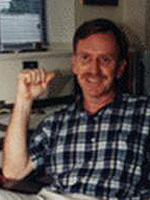- By Research Area
- By University
Directory
Faculty
Directory Details
[Return to Previous Listing]
Edward Phlips
Professor, Fisheries and Aquatic Sciences, University of Florida
Phone: (352) 273-3603
Fax: (352) 392-3627352
7922 NW 71st St.
Gainesville, FL 32653
http://fishweb.ifas.ufl.edu/Phlips/Phlips.htm
Education:
Ph.D., Marine Biology, 1981, University of Miami
Research Interests:
Ed Phlips came to the University of Florida in 1983, after a postdoctoral position at the Rosenstiel School of Marine and Atmospheric Sciences. The focus of his research has been the biology, ecology, and management of algae and aquatic microorganisms.
During the mid-80s this research effort dealt primarily with the potential for using marine algae to produce energy for human use, including hydrogen production by blue-green algae and the conversion of seaweeds to methane gas.
In the late 1980s his research focus shifted to the ecology of aquatic ecosystems. A seven-year study of Lake Okeechobee, Florida's largest freshwater body, addressed the factors that control primary production and water quality in this highly eutrophic ecosystem.
In 1993, two new research projects were initiated in the St. John's River, Florida's largest river, and Florida Bay, a major estuarine environment off the southern tip of Florida. Both of these projects dealt with the ecology of plankton communities. In Florida Bay, massive algal blooms threaten the health and stability of the unique tropical habitats within the Florida Keys, including the only major coral reefs in the continental United States. The goal of Dr. Phlips' research is to determine the causes and consequences of these blooms.
His most recent research initiatives deal with planktonic primary production in the Suwannee River estuary, located in Florida's Big Bend region, and in the Indian River Lagoon, along the east coast of Florida. His research in the Big Bend region is part of a broader department-wide initiative to address the multi-disciplinary research needs in this unique region of the state.
Most recently, Dr. Phlips has initiated a toxic algae research program, with the goal of evaluating the distribution, causes and consequences of harmful algae in both freshwater and marine ecosystems.
Publications List:
Badylak, S, K.Kelley and E.J. Phlips. 2004. A description of Pyrodinium bahamense (Dinophyceae) from the Indian River Lagoon, Florida, USA. Phycologia 43 (6):653-657. PDF
Badylak, S. and E.J. Phlips. 2004. Spatial and temporal patterns of phytoplankton composition in a subtropical coastal lagoon, the Indian River Lagoon, Florida. USA. J. Plankton Res. 26(10):1229-1247.PDF
Bledsoe, E. L., E.J. Phlips, D.E.Jett and K.A. Donnelly. 2004. The relationships among phytoplankton biomass, nutrient loading and hydrodynamics in an inner-shelf estuary. Ophelia 58 (1);29-47. PDF
Phlips, E.J., S. Badylak, S. Youn and K. Kelley. 2004. The occurrence of potenially toxic dinoflagellates and diatoms in a subtropical lagoon, the Indian River Lagoon, Florida, USA. Harmful Algae 3:39-49. PDF
Phlips, E.J. ,S. badylak and T. Grosskopf. 2002. Factors affecting the abundance of phytoplankton in a restricted subtropical lagoon, the Indian River Lagoon, Florida, USA. Estuarine, Coastal and Shelf Science. (in press) . PDF.
Phlips, E. J. 2001. Encyclopedia of Environmental Microbiology. John Wiley & Sons, Inc. New York.
Phlips, E. J. 2001. The Toxic Algae Threat in Florida. Florida Lake Management. 14(3)5-9.
Florida LAKEWATCH Web Site.
Bledsoe, E.L. and E.J. Phlips. 2000. Relationships between phytoplankton standing crop and physical, chemical, and biological gradients in the Suwannee River and Plume Region, U.S.A. Estuaries 23(4):458-473. PDF
Phlips, E. J., S. Badylak and Tammy Lynch. 1999. Blooms of the picoplanktonic cyanobacterium Synechococcus in Florida Bay, a subtropical inner-shelf lagoon. Limnol. Oceanogr. 44 (4):1166-1175. PDF
Phlips, E. J., M. Cichra, F. J. Aldridge and J. Jembeck, J. Hendrickson and r. Brody. 2000. Light availability and variations in phytoplankton standing crops in a nutrient-rich blackwater river. Limnol. Oceanogr. 45 (4): 916-929. PDF
Phlips, E. J., M. Cichra, K. Havens, C. Hanlon, S. Badylak, B. Rueter, M. Randall and P. Hansen. 1997. The control of phytoplankton abundance and structure by nutrient and light availability in a shallow subtropical lake. Journal of Plankton Research 19: 319-342. PDF
Phlips, E. J. and S. Badylak. 1996. Spatial distribution and composition of algal blooms in Florida Bay. Bulletin Marine Science 58(1): 203-216.
Phlips, E. J., T. C. Lynch and S. Badylak. 1995. Chlorophyll a, tripton, color and light availability in a shallow tropical inner shelf lagoon, Florida Bay. Marine Ecology Progress Series 127: 23-234. PDF
Phlips, E. J., F. J. Aldridge and P. Hansen. 1995. Patterns of water chemistry, physical and biological parameters in a shallow subtropical lake (Lake Okeechobee, Florida). Arch. Hydrobiol. Beih. Ergebn. Limnol. 45: 117-135.
Phlips, E. J., F. J. Aldridge, P. Hansen, P.V. Zimba, J. Ihnat, M. Conroy and P. Ritter. 1993 .Spatial and temporal variability of trophic state parameters in a shallow subtropical lake (Lake Okeechobee, Florida, USA). Arch. Hydrobiol. 128(4):437-458. PDF














